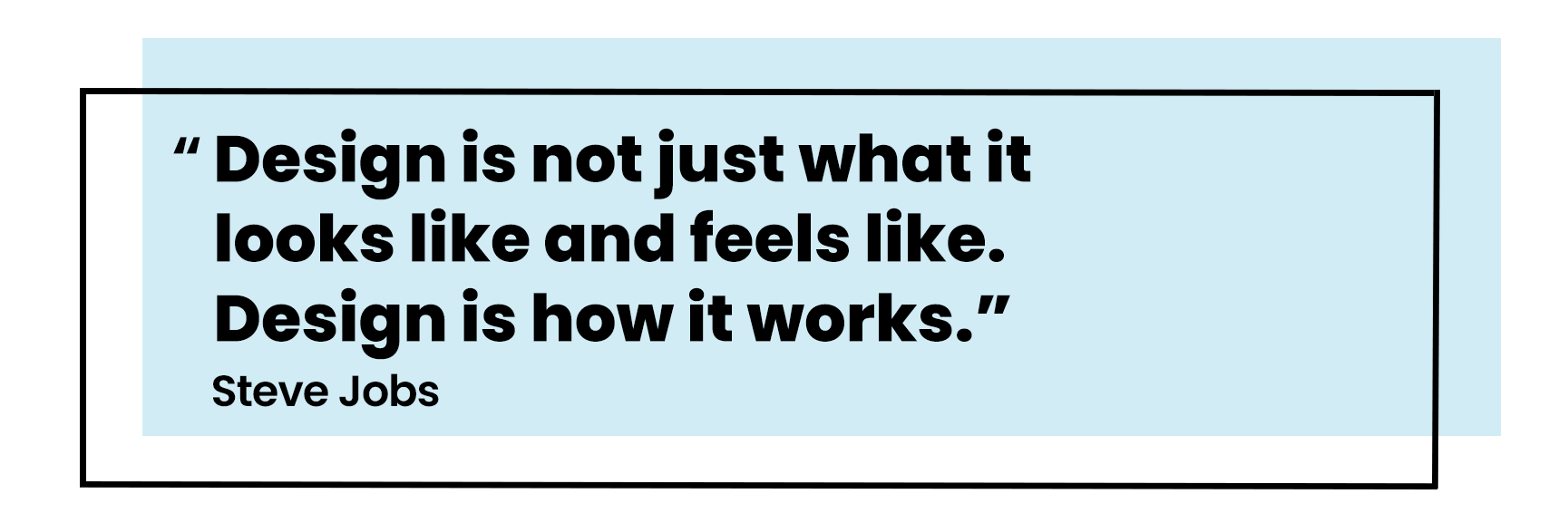
The importance of UX design
User experience (UX) design is essential for creating impactful and satisfying interactions with your brand. We highlight the significance of UX in meeting business objectives and user needs, detailing fundamental principles, benefits, and strategies for successful UX implementation. Explore how good UX drives customer loyalty, increases sales, and provides a competitive edge.

User and audience research | 12 MIN READ
Gone are the days that we consider user experience (UX) an area that only concerns designers; the role of creating a significant, lasting experience is now vital for fulfilling business objectives as well as your audience's needs. UX focuses on the end user's overall experience, including their perceptions, emotions, and responses to a product, system, or service. Generated using years of our industry knowledge, this guide will help you to understand the fundamental principles of UX and why it should be at the forefront of your digital strategy.
UX plays a critical role in attracting and maintaining your customer base. For most potential customers, you only get one chance to impress – most visitors decide within a matter of seconds whether to stay on your site or to exit and look for something better. So, the stakes are incredibly high.
Lee Colbran, Co-founder
What is UX?
Think of a website or app you love using. What do you love about it? Is it easy to find local accommodation to meet your needs within seconds? The ability to order an item with one click that will arrive the next day? The availability of diverse information all in one place?
No matter what it is, your favourite site was created with the end-user (you) in mind to deliver a simple and intuitive experience, provide you with what you're looking for, and make intelligent decisions based on your specific needs or challenges. This concept is user experience or UX.
While it is difficult to provide a single definition of UX, internationally agreed ISO standards define "user experience" as:
"User's perceptions and responses that result from the use and anticipated use of a system, product or service."
Delving deeper into this definition, "perceptions and responses" also include all emotions, preferences, behaviours, and accomplishments experienced by the user before, during and after interaction with the product. When defined in this way, you can see how complex UX can be.

One thing that it is important to note, the term "UX" is often used interchangeably with some of its key components, "user interface design" and "usability". Though user interface design and usability are vital components, UX covers several areas, including user research, content strategy, information architecture, etc. While each component is valuable, UX encompasses all aspects of the end-users interaction with your company, its services, and its products.
- User Interface (UI) Design focuses on the look and feel of a digital product, aiming to create interfaces that users find aesthetically pleasing and easy to interact with
- Usability measures how well a specific user in a particular context can use a product to achieve a goal effectively, efficiently and satisfactorily.
Why should you care about UX?
UX plays a critical role in attracting and maintaining your customer base. For most potential customers, you only get one chance to impress – most visitors decide within a matter of seconds whether to stay on your site or to exit and look for something better. So, the stakes are incredibly high.
Many years of a customer-first approach at Fresh Egg have proven that UX is critical to the overall customer experience. Here are five key reasons why you should invest in UX:
1. Increases sales
The more satisfied your users are, the more likely they will do what you encourage them. Though it is tough to quantify how much good UX can increase your revenue, one often-quoted statistic is that every $1 spent on UX has a return on investment of $2 to $100. The evidence suggests that it's closer to the upper end of that range.
- One famous example is the $300 million button, whereby Amazon's purchase funnel forced users to select "Register" or "Login" at checkout. Amazon predicted that customers would be pleased to register and save time on future visits. However, when replacing "Register" with a "Continue" button that didn't require registration, conversions increased by 45%, leading to an additional $300mil revenue in the first year.
2. Saves you money
One key reason cited by businesses for not adopting UX practices is cost.
Therefore, you need to consider how bad UX can impact a business vs the comparably small cost of good UX. The consequences of bad UX lead to friction and frustration for the user.
This can present in many costly ways, for example:
- Users don't register – where a lead generation form or registration component fails to follow a simple and logical flow, the customer will abandon it before signing up.
- ROI diminishes – any paid traffic that delivers a poor conversion rate will have a low ROI, and you'll have lost future revenue from the abandoned user.
- Shopping cart abandonment – UX can play a big part in the friction that shoppers experience. Some key frustrations include difficulty making changes to their cart, costs not being fully explained upfront, and being forced to sign in or complete lengthy forms.
It's not just the direct costs of bad UX that can impact a business. It shows that developers spend up to 50% of their time on avoidable rework. Getting it right to start with can reduce employee churn, as reworking preventable issues can be a thankless task.
There are entire areas of functionality in many software products that users fail to discover. Developing features costs time and money, yet there are no benefits to the business if very few people see them. Simple user tests can help us identify whether users can discover the features and whether they would use them.

Good UX means that sites are intuitive and understandable. When the experience is fulfilling and successful, users shouldn't need to call or send an email to figure something out, meaning you can put fewer resources into staffing customer services.
Chat with our team about helping you with UX design
3. Improves customer loyalty
88% of users online are unlikely to return to a website after a negative experience. Good UX isn't just about easy navigation and optimised copy; it's also about creating memorable, positive experiences for your customers. Great UX brings delight to your users, inspiring them to advocate your product to others and become loyal customers.
4. Provides a competitive advantage
Some of the world's largest companies have significantly invested in UX – Apple, Amazon, Tesla, and Meta. They have a detailed understanding of their customer base and how to meet their needs efficiently and effectively. Consider the quality of your experience when using some of the world's largest mobile apps – TikTok, Instagram, WhatsApp, and Spotify. In today's digital market, users expect your website to provide a good experience, making UX a matter of survival.
5. More impactful marketing
Digital marketing educates the target audience on the value of a product and persuades them to take some action; success can be significantly improved by understanding what your users respond well to. Good UX (especially through effective user research) means gaining a deeper understanding of your users and what they’re looking for, allowing you to create clearer and more effective marketing messages for them.
6. Improved search visibility
Google doesn’t tell us all the ways it tries to measure user experience or how they fit together, but we know that it wants to direct its own users to content that is accessible and usable. Many of its algorithm updates focus on improving how it does this, and it runs its own forms of user testing to get direct feedback from users. For example, we’ve written previously about how Google’s “Page Experience” update saw SEO and UX overlap more closely than ever before.
Many users' first experience of your brand and content might well be within Google's search results, and what they see influences whether (or not) they click. Thinking about the user experience from a search perspective is an important part of any SEO's role.
Mark Chalcraft, Head of Technical SEO
When SEO and UX specialists work together, users benefit. For example, the transition from search result to the site will be smoother, making it easier to see content relating to their keyword search immediately.
That doesn't mean that improving on-page engagement metrics tracked in Google Analytics will directly impact your rankings (a common SEO myth that Google has often debunked). However, combining a great experience with helpful, informative content builds trust in your users. Over time, this will benefit your SEO performance – we know that search engines have the means of measuring user trust, including through machine learning, even if they don't reveal exactly how.
Critical elements of great user experience

While there are many ways to break down the essentials of UX, the most common is the UX Honeycomb (depicted above), which outlines the primary elements of a high-quality user experience:
- Findable – Your content must be navigable and locatable online and offsite so that users can find what they need. Is the information your user seeks easy to find, or the following action they must take?
- Usable – Usefulness doesn't mean functional. Usability concerns your users' ability to achieve their end goal effectively and efficiently. How many clicks does it take a user to reach their desired page?
- Accessible – Your product or service should be available and accessible to all users of various abilities. Would a colourblind user be able to distinguish between visual elements? Can a user reach their desired page using keyboard navigation only? Is your content understandable to a user with learning or cognitive difficulties?
- Useful – The core of UX is to identify user needs and address them. Does your product solve the user's problem in a way they would like it to be solved? Your product or service must serve a purpose for your target audience(s).
- Valuable – A product or service must hold value to the user. Consider the product or service's uniqueness and how it will add value to the customers' lives.
- Credible – Reputation is critical to a brand, so successful UX design must address credibility. Incorporating consistency and trust into your product or service will increase the likelihood of its success.
- Desirable – Desirability doesn't just come from branding. UX is a crucial contributor. If a product or service isn't desirable, there's little motivation for the customer to engage. How are people going to be attracted to your product or service? Is your new feature adding value?
The seven elements of the UX Honeycomb support marketers, developers, and business owners to identify UX priorities in developing a solid, informed UX design. Integrating each element ensures that the UX design is cohesive and user-friendly, boosting the success of the products or services.
“With the internet becoming more accessible, there is a greater importance on creating digital experiences that meet the needs of the many and not the few. Building empathy, understanding, and a bond with users before any design work are pivotal in creating digital solutions that are inclusive and successful in meeting their needs as well as business goals. The internet is full of examples of beautiful aesthetics and bad UX. Good UX takes effort and understanding - everyone will reap the rewards if you recognise its importance as part of your design and development process."
Sarah Simpson, Senior Experience Designer
What do UX practices look like?
Membership optimisation for the charity sector versus SEO migration for an e-learning specialist versus revenue improvement for an online retailer requires different processes, tasks, and attitudes.
In our experience, we know that one size does not fit all when it comes to creating a first-class user experience. UX doesn't follow a rigid process – each project has a different scope, background, complexity, starting point, and goal. However, the underlying practice follows common principles, which we have outlined below.
 Understand
Understand
When: Before you can build a product or even a strategy, you must understand its context, for example:
• Who is your target audience?
• What issue are you trying to solve?
• Why is your product the one with the answers?
Researchers must also incorporate the needs of the organisation. What are the goals, the challenges, and the technical constraints?
To find practical solutions, first, clearly define the problems.
Example methods: stakeholder workshop, empathy mapping, market research.
Result: A deep understanding of your target audiences, your brand, and how the project aligns with these. 

Research
When: You have questions that are blocking you from moving forward. You must understand your product or service from the view of your users. Research enables us to put ourselves in our users' shoes: helping us (as researchers) to understand their likes, dislikes, context, needs, pain points, etc.
Better research leads to better, more informed decisions.
Example methods: user testing, card sorting, tree testing, heuristic evaluation.
Result: Qualitative raw data such as interview transcripts, observation notes, and diary study entries. Quantitative raw data such as survey results, data analytics statistics, and decision trees.


Analyse
When: You have a collection of detailed information that you need to interrogate and distil the essential elements.
Example methods: affinity mapping, customer journey mapping.
Result: A report detailing actionable insights and resulting recommendations, backed by foundational takeaways and knowledge from research. Depending on your requirements, this can be a standalone piece to be used in-house or form part of a more comprehensive UX project.


Design
When: When you understand the project's requirements and underlying information, you need to come up with design ideas.
Example methods: Content strategy, information architecture, wireframing, prototyping.
Result: Physical representations of ideas – depending on the project requirements, this can vary from low-fidelity wireframes to high fidelity prototypes, up to fully coded designs ready for the finished product.


Test
When: When you've gathered enough information and agreed on final designs, now you're ready to launch to the public and, where appropriate to the project, continue the final stage of testing.
Example methods: A/B testing, user testing, surveys, data analytics.
Result: A functional live product or service may also have a further testing and refinement programme. An ongoing digital strategy may be the final deliverable, depending on the project.
How to improve UX and generate results - Common mistakes to avoid
Now that you know what UX is, the key considerations, and how the general principles are applied, it's worth concluding with some UX common mistakes and misconceptions.
1. Considering UX only in the first phase of a project:
Many businesses think that UX is limited to sketching interfaces. As we've discussed throughout, it is a much broader process that ideally starts at the strategy level and impacts a project's lifecycle. Working on real-time user feedback and in-depth competitor analysis can avoid UX design challenges at any stage. Even when you have an established website, working on feedback provided by actual users makes you understand the "why's" of user behaviour and what the best solutions are.

2. Designing for yourself:
A famous mantra exists in the UX world: "You are not the user". Historically, some design and development teams have naturally formed rigid outlooks about the products they are developing, leading to products that aren't user-centric. Avoid this by learning about your users, involving them in the design process, and interacting with them.
3. Prioritising aesthetics over functionality, or vice versa:
Your website should strike a balance between functionality and creativity. While aesthetics are essential for UX and users appreciate creativity, they must be able to navigate your site easily. On the other hand, attractive things work better. If you focus only on functionality, your site may be unappealing to users and compel them to search elsewhere.
4. Ignoring responsive design:
Responsive design is an established part of owning a successful website. Responsive design allows your user to avoid the unnecessary resizing, scrolling, zooming, or panning which occur with sites that do not have an optimal set-up for different devices. However, we still encounter websites that do not snap correctly to make the best use of the available screen real estate. With more people accessing websites via mobile devices than desktops, ignoring responsive design can be costly.
5. Forgetting content:
Do not underestimate the importance of your content; the fact is, users, visit your site for the content, not the design. Your website needs on-brand high-quality, authoritative content from experts for optimal UX. The focus of your content should be on your users (and not a search engine).

Read our guide about choosing the right user testing method
Watching users undertake tasks allows businesses to find out where their audiences may be experiencing confusion and any difficulties they are having. Findings from user testing give clear direction for design changes or A/B tests.
In summary
As we've shown, underplaying the benefits of UX for your business can cause issues. The long-term merits of investing in a sound user experience include better ROI, lower expenses, better customer retention, and higher Google rankings. Your customers will look elsewhere if you fail to please their needs - remember, it's a competitive world. If you want to avoid that, you must give UX the focus it deserves.
Customer experience drives our digital marketing. Everything we do starts with understanding your audiences and improving their journeys. We blend real-world insights and data with creativity to ensure the final result delivers your business objectives. If you need support with improving the user experience of your website, we can help.
Further reading
Do you have a challenge we can help you with?
Let's have a chat about it! Call us on 01903 285900



